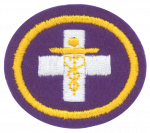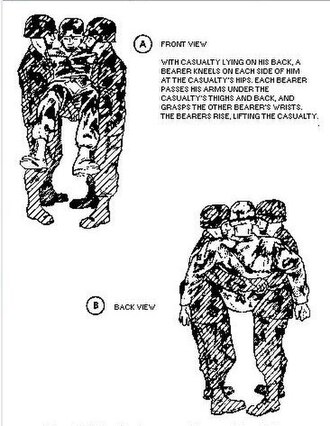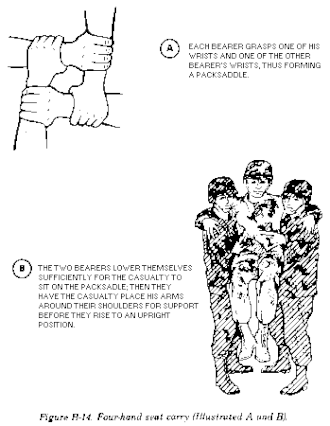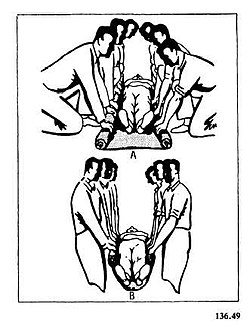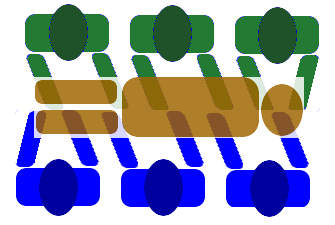Difference between revisions of "AY Honors/Basic Rescue/Answer Key/es"
(Created page with "<!--d. Traslado en una manta--> thumb|250px|left|Una camilla improvisada hecha de una manta.") |
(Created page with "La víctima se coloca boca arrivba en el medio de la manta. Tres o cuatro personas se arrodillan en cada lado y rodan las orillas de la manta hacia la víctima, como se muestr...") |
||
| Line 170: | Line 170: | ||
[[File:Improvised_stretcher_blanket.jpg|thumb|250px|left|Una camilla improvisada hecha de una manta.]] | [[File:Improvised_stretcher_blanket.jpg|thumb|250px|left|Una camilla improvisada hecha de una manta.]] | ||
| − | + | La víctima se coloca boca arrivba en el medio de la manta. Tres o cuatro personas se arrodillan en cada lado y rodan las orillas de la manta hacia la víctima, como se muestra en la parte A de la imagen. Cuando los bordes enrollados estén bien ajustados y lo suficientemente grande como para captar de forma segura, la víctima debe ser levantada y llevada como se muestra en la parte B de la imagen. | |
<br style="clear:both"> | <br style="clear:both"> | ||
Revision as of 18:36, 9 January 2021
| Rescate básico | ||
|---|---|---|
[[AY Honors/Basic Rescue/es|]]
|
Destreza: Año de introducción: |
|
Requisitos
|
La especialidad de Rescate básico es un componente de la Maestría Salud y Ciencia. |
| Conexión Logros para la Investidura: Esta especialidad está relacionada con los requisitos de Logros para la Investidura para EXPLORADOR Salud y Aptitud Física que requiere el desarrollo completo de esta especialidad. |
1
Un rescate es el acto de remover a alguien de peligro. Un rescate de emergencia es un término técnico para un rescate que toma lugar en circunstancias peligrosas y con alto riesgo para los rescatadores, pero se debe hacer de inmediato para salvar la vida de una persona. En esta clase de escenario, decir que una persona está en peligro inmediato puede ser subestimado, normalmente si no se remueve de su circunstancia lo más pronto posible, la víctima morirá muy pronto. Los rescates técnicos y rescate son descriptivos de muchas clases de circunstancias, en todos los casos la víctima está en peligro. Un gato en un árbol o una persona de otra manera ileso atrapado en un carro chocado no van a morir en esos mismos instantes, pero tendrán que ser rescatados de esas circunstancias por alguien con los medios y la habilidad de hacerlo.
2
2a
2b
2c
2d
2e
3
4
- La víctima ha dejado de respirar
- La víctima tiene sangrado severo
- La víctima está siendo eléctricamente conmocionado
- La víctima tiene un ataque al corazón
- La víctima está en llamas
- La víctima se está ahogando
- La víctima ha sido envenenado
5
- La primera cosa que hacer es evaluar la situación y planificar el rescate.
- Asegúrese de que puede realizar el rescate sin lastimarse.
- Asegúrese de que el traslado de la víctima no causará lesiones adicionales.
- Sepa donde va a mover a la víctima antes de levantarla.
- Si se debe pedir ayuda de otras personas, es importante que sepan detalladamente qué es lo que quiere que hagan.
- A menos que el peligro sea inmediato, los primeros auxilios se deben hacer antes de mover a la víctima.
- Si sospecha que hay una lesión en la columna vertebral, no mueva a la víctima.
6
- Asegúrese de que sea necesario mover a la víctima. Si no lo es, no mueva a la víctima.
- Sepa cómo va a mover a la víctima antes de intentar moverla.
- Sepa dónde se va a mover a la víctima antes de intentar moverla.
- Asegúrese de que usted es capaz de levantar a la víctima antes de levantarla. Si la víctima es demasiada pesada, la puede arrastrar en su lugar.
- Mantenga su equilibrio. No inicie el movimiento desde una posición desequilibrada.
- Mantenga su equilibrio durante todo el movimiento.
7
7a
Adventist Youth Honors Answer Book/First aid/Shoulder drag/es
Adventist Youth Honors Answer Book/First aid/Blanket drag/es
7b
Adventist Youth Honors Answer Book/First aid/Firemans carry/es
Adventist Youth Honors Answer Book/First aid/Pack strap carry/es
7c
8
8a
Dos rescatadores también pueden mover a una víctima por medio de sentarla en una silla:
- Rescatador 1: Mirando a la parte posterior de la silla, agarre los montantes traseros.
- Rescatador 2: De espaldas a la víctima, alcance hacia atrás y agarre las dos patas delanteras de la silla.
- Ambos rescatadores: Incline la silla hacia atrás, levante y salga.
8b

8c
El transporte de silla de dos manos se utiliza cargar a una víctima por una corta distancia y ponderla en una camilla.
Sólo una víctima consciente puede ser transportado con el transporte de silla de cuatro manos porque tiene que ayudar a mantenerse a sí mismo mediante la colocación de sus brazos en los hombros de los rescatadores. Este transporte es especialmente útil en el transporte de una víctima con una herida en la cabeza o el pie y se utiliza cuando la distancia para recorrer no es tan lejos. También es útil para la colocación de una víctima en una camilla.
8d
La víctima se coloca boca arrivba en el medio de la manta. Tres o cuatro personas se arrodillan en cada lado y rodan las orillas de la manta hacia la víctima, como se muestra en la parte A de la imagen. Cuando los bordes enrollados estén bien ajustados y lo suficientemente grande como para captar de forma segura, la víctima debe ser levantada y llevada como se muestra en la parte B de la imagen.
8e
The three-person hammock carry is very similar to the two-person carry, except that three people are involved: One positioned at the victim's calves, one at the hips, and the third person at the shoulders. The carriers kneel on their knee nearest the victim's feet. The person at the victim's head gives the command, and all three lift the victim to their knees simultaneously. The victim is then turned so that he faces the rescuers. The person at the head then gives the command and the three rescuers stand.
8f
8g
9
Adventist Youth Honors Answer Book/First aid/Litter carry
Adventist Youth Honors Answer Book/First aid/Improvised litter
10
10a
Adventist Youth Honors Answer Book/Knot/Sheetbend
Adventist Youth Honors Answer Book/Knot/Square
Adventist Youth Honors Answer Book/Knot/Surgeons
10b
10c
10d
Separate the rope into two equal sized coils, with a little less than half the rope in each coil. Choose one end that you will hang on to, and grasp it firmly in the palm of one hand, using the three smallest fingers to hold it securely. Hold the rest of that coil between the index finger and thumb, and hold the other coil in the other hand. Take aim, and throw both coils toward the victim at the same time while retaining your grip on the end. If you have difficulty with this, try standing on the end of the rope you wish to keep with you. Using this method, you can throw the rope quite a bit farther than if you had thrown a single coil. This is because the second coil will not begin to unravel until the first one uncoils. Practice until you can hit a target with the rope from the 50-foot (15 meter) mark.
11
Before reporting:
- Children
If at home check your home carefully, contact your child's friends and your neighbors quickly to see if your child is with one of them. If at a store or mall contact management or security and have the child paged, if needed many stores today will "lock down" until all people and places are checked. If in a public place, do not panic. Try a high spot such as a chair or table to get a better vantage, and contact the facility management if there is one.
Gather yourself and be prepared to provide information to the police that will be relevant to the search for your child.
- Adult
Adults must be missing for 24 hours and in some places 48 hours before a report can be filed. Contact known friends, work, and hang outs before reporting an adult missing. Adults who are mentally unstable for any reason or in need of medication for survival can normally be reported immediately as missing.
- Those on outings
If you are expecting loved ones to return from an outing and they are overdue be sure to contact their various phones and their home before calling authorities. If this is travel, some delays may be caused by weather and other circumstances that can be checked by calling the airport or travel authority for their means of travel. Road conditions can normally be checked through the state's department of transportation or the department of public safety (Highway Patrol). For those who were camping, hiking, or the like you will contact the forest/park authority for weather and road issues.
Be sure to have information on planned hiking routes and camping locations left behind by your loved ones so they can be used in a search if needed.
- What will be needed
The more detailed your physical description to police can be the better. The color of eyes, hair and skin are needed but are not truly distinctive. Pictures are best and any identifying marks such as scars will help to identify a particular person quite well. The clothes the missing or lost person was wearing when last seen are very helpful too, as well as details on the vehicle(s) any adults may have been driving when last seen.
Age, date of birth, and other personal details such as family nicknames and family known information are helpful in child abduction cases. This information can not only be used to identify a child but to retrieve the child and gain trust with police. The person's doctor and dentist will also be helpful so have those names ready if possible.
- Searches
Adventist Youth Honors Answer Book/First Aid/Searches
References
- Pages using DynamicPageList3 parser function
- Categoría: Tiene imagen de insignia
- Adventist Youth Honors Answer Book/Honors/es
- Adventist Youth Honors Answer Book/es
- Adventist Youth Honors Answer Book/Skill Level /es
- Adventist Youth Honors Answer Book/Honors Introduced in /es
- Adventist Youth Honors Answer Book/Unknown/es
- Adventist Youth Honors Answer Book/Unknown/Primary/es
- Adventist Youth Honors Answer Book/Stage 100/es
- Categoría:Libro de Respuestas de Especialidades JA/Maestría Salud y Ciencia/B
- Adventist Youth Honors Answer Book/IAConnection/es
- Adventist Youth Honors Answer Book
